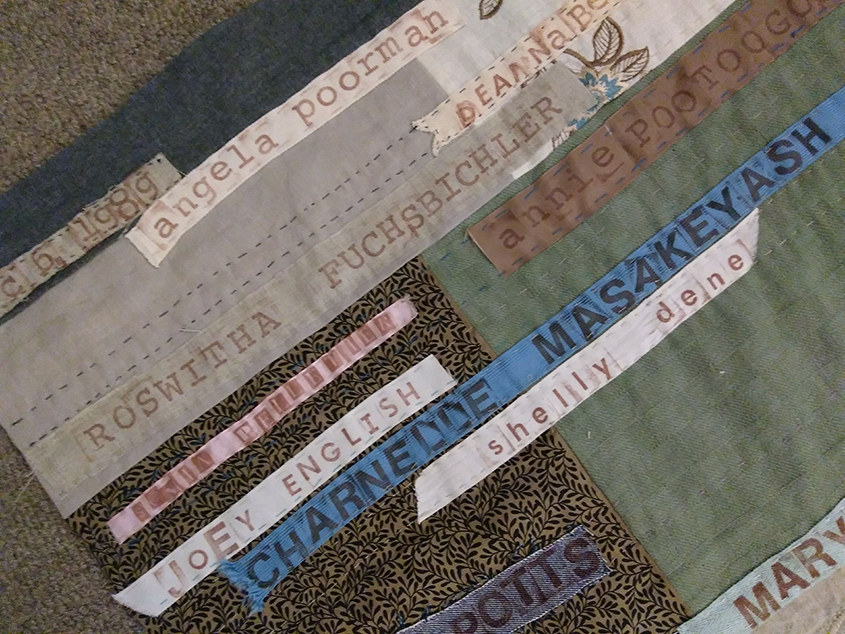The Generator project from September 28 to November 3, 2019 at Central Gallery.
September 29, 7:00 PM-12:00AM, September 30, 4:00-8:00 PM, October 1, 12:00-4:00 PM,and to October 2, 4:00-8:00 PM: Lois Klassen and Lori Weidenhammer: Slofemists
October 12, 2:00-4:30 PM: Mindy Yan Miller and Suzanne Miller: Needle and Thread
October 18 to 20, 1:00-5:00 PM: Heather Majaury and Terre Chartrand: Neighbours: A Community Quilting Project
October 25 to 27, 12:00-4:00 PM: Stacey Fayant: Hand-Sewn with Love/kashkwaykashoon a maen avik shakihitowin
Featuring installations, performances, workshops and community stitching sessions, A Stitch and Time investigates stitching as traditional practice, as activism, as a means of commemoration, and as a tool for community building and intercultural exchange. In Lori Weidenhammer and Lois Klassen’s Slofemist project, community members join the artists to create embroidered patches commemorating feminist heroes. Mindy Yan Miller and Suzanne Miller’s Needle and Thread is a commemorative performance and installation reflecting on the Holocaust. To address the Truth & Reconciliation’s Call to Action #93, Heather Majaury and Terre Chartrand’s Neighbours: A Community Quilting Project encourages story sharing between newcomers to Canada and Indigenous peoples. In Hand-Sewn with Love/kashkwaykashoon a maen avik shakihitowin Métis artist Stacey Fayant will provide comfort, love and medicine by tattooing the skin of friends using traditional skin-stitching methods.
The Generator is a seasonal presentation series featuring community engaged projects that are created or led by artists, and often presented in alternative and digital spaces to increase access to art and artists.


Lois Klassen and Lori Weidenhammer, Slofemists, 2018, collaborative and participatory artwork, Emily Carr University Library. Photo: Lois Klassen.
Christina Battle, William “Billy” Beal, Anna Binta Diallo, Cheryl Foggo, Judah Iyunade, Richard Allan Thomas, Chukwudubem Ukaigwe, NASRA, Frank B. Jamerson fonds
BLACK PRAIRIES honours more than one hundred years of Black/African-Canadian cultural production in the Prairies, spanning the 1920s to the present, with a focus on lens-based media. The exhibition includes newly commissioned contemporary artwork, original glass plate negatives by early 1900s Black Manitoban photographer William “Billy” Beal, and archival photographs from the City of Edmonton’s Frank B. Jamerson fonds.
Beal’s glass plate negatives, taken between 1915 and 1925, document homesteading life in western Manitoba from the perspective of a lone Black man living in an all-white rural township during the early 1900s. Meanwhile, the photographs in the Frank B. Jamerson fonds, created by unnamed photographers, depict everyday Black life in and around Amber Valley, Alberta—a historic community formed during the Great Black Migration of 1910. This migration saw African-Americans fleeing racial violence in the United States to seek refuge in the Canadian Prairies. The selected photographs in this exhibition capture the first thirty years after the migration, reflecting the experiences of the first generation of Black migrants in the region. The contemporary artists in this exhibition foster important dialogues about personal histories, a changing climate, and collective experiences in the region.
Additionally, the exhibition includes the newly created short film For Caesar by filmmaker Cheryl Foggo. The film features Leander Lane, the great-grandson of Julius Caesar Lane, a founding member of the Shiloh People, the historic African-Canadian community in Saskatchewan.
BLACK PRAIRIES provides space for communal grounding and reflection on the ongoing and ever-expanding continuum of Black life and Black cultural production in the Prairies.
Image: Rosa and Mary, Amber Valley, Alberta c. 1940, black and white photograph, 5 x 6 cm. Frank B. Jamerson fonds, courtesy City of Edmonton Archives.